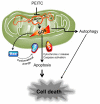Mitochondrial dysfunction in cancer chemoprevention by phytochemicals from dietary and medicinal plants
- PMID: 27867044
- PMCID: PMC5435556
- DOI: 10.1016/j.semcancer.2016.11.009
Mitochondrial dysfunction in cancer chemoprevention by phytochemicals from dietary and medicinal plants
Abstract
Cancer chemoprevention, a scientific term coined by Dr. Sporn in the late seventies, implies use of natural or synthetic chemicals to block, delay or reverse carcinogenesis. Phytochemicals derived from edible and medicinal plants have been studied rather extensively for cancer chemoprevention using preclinical models in the past few decades. Nevertheless, some of these agents (e.g., isothiocyanates from cruciferous vegetables like broccoli and watercress) have already entered into clinical investigations. Examples of widely studied and highly promising phytochemicals from edible and medicinal plants include cruciferous vegetable constituents (phenethyl isothiocyanate, benzyl isothiocyanate, and sulforaphane), withaferin A (WA) derived from a medicinal plant (Withania somnifera) used heavily in Asia, and an oriental medicine plant component honokiol (HNK). An interesting feature of these structurally-diverse phytochemicals is that they target mitochondria to provoke cancer cell-selective death program. Mechanisms underlying cell death induction by commonly studied phytochemicals have been discussed rather extensively and thus are not covered in this review article. Instead, the primary focus of this perspective is to discuss experimental evidence pointing to mitochondrial dysfunction in cancer chemoprevention by promising phytochemicals.
Keywords: Chemoprevention; Electron transport chain; Mitochondrial dynamics; Mitochondrial dysfunction; Phytochemicals.
Copyright © 2016 Elsevier Ltd. All rights reserved.
Figures



References
-
- Bai X, Cerimele F, Ushio-Fukai M, Waqas M, Campbell PM, Govindarajan B, Der CJ, Battle T, Frank DA, Ye K, Murad E, Dubiel W, Soff G, Arbiser JL. Honokiol, a small molecular weight natural product, inhibits angiogenesis in vitro and tumor growth in vivo. J Biol Chem. 2003;278:35501–35507. - PubMed
Publication types
MeSH terms
Substances
Grants and funding
LinkOut - more resources
Full Text Sources
Other Literature Sources
Medical
Molecular Biology Databases
Miscellaneous

